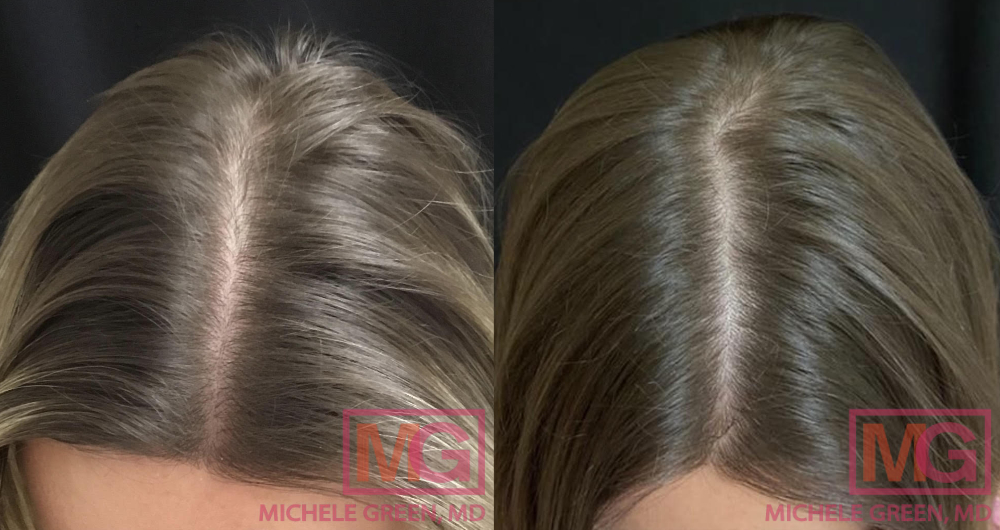Women’s Hair Loss and Alopecia
Hair loss can be a distressing condition for any woman who experiences it. There are many reasons why hair loss or thinning may occur, including genetics (female pattern hair loss or androgenetic alopecia), severe stress or trauma (telogen effluvium), autoimmune disorders (alopecia areata), or tight hairstyles (traction alopecia). According to published studies, androgenetic alopecia alone can affect up to 50% of women during their lifetimes, which amounts to around 30 million American women each year. Since each patient’ s hair loss is unique, understanding its underlying cause and addressing it is crucial for successful treatment. Dr. Green has over two and a half decades of experience treating her NYC patients with the most innovative treatment options available, including in- office procedures, topical products, and oral medications. With new, cutting- edge treatments, Dr. Green can diagnose and treat your hair loss, correct thinning hair, and stimulate new hair growth.
Some of the most popular hair loss treatment options include topical minoxidil solution, oral medications, platelet- rich plasma injections, and Keravive scalp treatment. Often, a combination of these treatments is best for reducing hair loss and regrowing hair. The treatment options best suited for you should be selected by an expert like Dr. Green, based on a professional assessment of your condition, your medical and family history, and the specific type of hair loss you are experiencing. If you are frustrated by signs of hair thinning or shedding and are ready to regrow your hair, Dr. Green is here to help.
As an expert in both cosmetic and medical hair loss treatments, board- certified dermatologist Dr. Michele Green is one of the first dermatologists in New York to incorporate PRP for treating male and female pattern hair loss patients. Due to her dedication to patients and her expertise, Dr. Green has been recognized as one of New York City’ s best dermatologists by publications such as Castle Connolly, New York Magazine, Super Doctors, and The New York Times. Whether your hair loss results from stress, hairstyles, hormones, medications, or other medical conditions, Dr. Green will conduct a thorough assessment of your hair and scalp to diagnose the cause. After this complete evaluation, she will recommend the best combination of interventions to promote hair regrowth and restore beautiful, healthy hair.
Types of female hair loss and thinning hair
Hair loss, also known as alopecia, can present in many different forms. The most common type of hair loss in women is female pattern hair loss, or androgenic alopecia. Other frequent types of hair loss in females include alopecia areata, telogen effluvium, and traction alopecia. When examining the various types of hair loss, it is essential to consider them in relation to the hair growth cycle. The hair growth cycle comprises four stages: the growth phase (anagen), the transition phase (catagen), the rest phase (telogen), and the shedding phase (exogen). The anagen phase is when individual hairs grow for an average of 3 to 5 years. The catagen phase is a brief transitional period during which hair completes its active growth cycle. In the telogen phase, or resting phase, hair remains in its follicle for approximately three months. Lastly, during the exogen phase, individual hair strands are released, resulting in hair falling out. These phases vary for each hair and follicle, so most patients do not notice a disruption in the growth cycle unless they experience significant thinning or shedding.
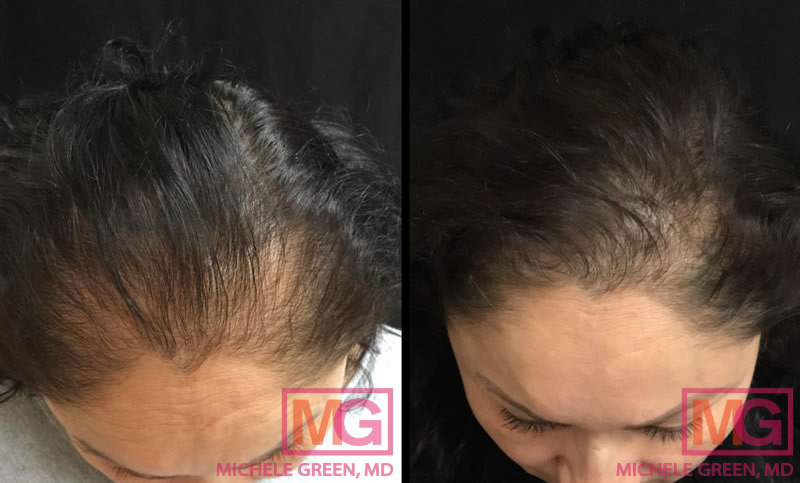
Before and after 4 sessions of PRP
Female pattern hair loss (FPHL)
Female pattern baldness, also known as androgenic or androgenetic alopecia, is characterized by traits similar to those of male pattern baldness. However, in women, a receding hairline is less common. Instead, female pattern hair loss (FPHL) is marked by thinning hair along the part line, which resembles a widening part, followed by hair loss from the top of the head. The widening part is often referred to as the “Christmas Tree pattern” due to its likeness to an upside-down Christmas tree. Like male pattern baldness, female pattern baldness is also thought to result from imbalances in androgen hormones. Additionally, there may be a genetic component to this type of hair loss. Sensitivity to androgens can weaken the hair shaft, reducing the length of the anagen phase of the hair growth cycle while lengthening the exogen phase.
Female pattern hair loss is classified as Type I (minimal thinning that can be concealed with the right hairstyle), Type II (decreased volume and noticeable part widening), and Type III (increased hair shedding with a noticeably visible scalp). Androgenic hair loss is considered a genetic medical condition; however, it can also result from endocrine disturbances and rare androgen-secreting tumors of the adrenal glands, ovaries, or pituitary gland gland.
Alopecia Areata
Alopecia areata is an autoimmune condition in which the body’s immune system attacks healthy hair follicles, resulting in patchy hair loss that appears as circular bald patches on the scalp. Alopecia areata can occur alongside stress, thyroid disease, anemia, and diabetes. Dr. Green will carefully inspect your scalp and hair to determine the cause of hair loss and will order the appropriate blood work. Alopecia areata typically causes bald spots the size of a quarter, but the size and number of spots can vary from person to person. The condition can be treated with steroid injections, promoting hair regrowth. When hair loss affects all of the hair on one’s head, it is referred to as Alopecia Totalis. A specific type of alopecia areata, which manifests as hair loss in a band around the sides and back of the head, is known as ophiasis alopecia areata and may be more challenging to treat.
Traction Alopecia
Traction alopecia is a hair loss condition typically caused by repeated restrictive or tight hair styling. When patients wear tightly pulled hairstyles such as braids, cornrows, ponytails on top of the head, buns, or pigtails, breakage and irritation to the hair follicles can occur. Ballet dancers often wear their hair in a tight bun and frequently suffer from traction alopecia. This condition usually appears where the hair is pulled back and becomes more noticeable as the hair falls once the hairstyle is undone. Traction alopecia can be reversed if treated quickly and appropriately. Otherwise, this type of hair loss can be permanent.
Telogen Effluvium
Telogen effluvium is a type of hair loss associated with a disruption in the hair cycle. Hairs shift from the anagen (growth) phase to the telogen (resting) phase simultaneously and then move into the exogen (shedding) phase. This results in a significant amount of hair shedding occurring all at once before the hair cycle resets. Telogen effluvium is usually triggered by a disruptive event, such as undergoing a surgical procedure, experiencing generalized anesthesia, suffering from a physical accident or injury, or dealing with chronic stress. Some individuals notice telogen effluvium shortly after pregnancy as hormone levels stabilize and the body recovers from the impact of childbirth. Patients recognize the condition when the widespread shedding results in more strands of hair than usual falling out while showering or combing their hair. Typically, telogen effluvium begins three to four months after the stressor is resolved and can last for up to a year. Once shedding ceases, hair will start to regrow over several months.
6 months before and after – 3 PRP treatments
What causes hair loss in women?
Many patients in Dr. Green’ s private dermatology office ask, “Why do women’s hair fall out?” Hair loss is multifactorial, with many potential causes. Factors such as hormonal imbalances, genetic predisposition, nutrient deficiencies, autoimmune diseases, and stress can lead to hair loss. The most common cause is hormonal imbalances and elevated levels of androgens in the body. Regarding female pattern baldness, androgens often trigger hair loss and thinning, with sensitivity to androgens being hereditary. Hormonal changes during pregnancy and menopause, including excess androgens, can also manifest with symptoms beyond hair loss, such as acne and menstrual irregularities. In addition to androgen- related hair loss, various factors can contribute to this condition. Telogen effluvium can affect anyone who has recently experienced a traumatic event or is enduring prolonged high stress. Patients who have undergone surgery with general anesthesia may experience rapid, short- term hair loss in the months following the procedure. Certain illnesses, like COVID, can also provoke telogen effluvium. Stress may lead some patients to unconsciously pull out their hair, a condition known as trichotillomania. Furthermore, individuals taking medications for cancer, blood thinning, or blood pressure often report hair loss. Nutritional deficiencies can also play a role, so those with restrictive diets, as well as individuals suffering from anorexia nervosa or bulimia, frequently experience hair loss.
Autoimmune diseases occur when the immune system mistakenly attacks the body, treating it as if it were foreign. Many autoimmune disorders have systemic effects, disrupting various bodily processes, including the hair cycle. Autoimmune diseases that can lead to hair loss include lupus, Sjogren’ s syndrome, lichen planopilaris, thyroid disorders like Hashimoto’ s or Graves’ disease, scalp psoriasis, Crohn’ s disease, and ulcerative colitis.
In some cases, hair loss may be a symptom of a broader health issue requiring further investigation. For instance, polycystic ovary syndrome (PCOS) often initially presents with thinning hair and increased acne and body hair. Additionally, thyroid problems such as hypothyroidism and hyperthyroidism can also cause hair loss. Many causes of hair loss exist, each with unique treatment options available. If you experience hair loss, the first step is to consult a board- certified dermatologist like Dr. Michele Green. To identify the cause of hair loss, Dr. Green will conduct a physical evaluation, perform blood tests for specific diagnoses, or collect a biopsy of the hair follicles.
Women’s hair loss treatments
When it comes to hair loss treatment, a variety of non-invasive options can support hair regrowth and overall hair health. These treatments require no downtime and promote long-term hair growth. When you consult with Dr. Green, she will assess your hair loss before creating a personalized treatment plan that may include a unique combination of in-office procedures, oral medications, and topical products to stop your hair loss. If hair loss is severe, some patients opt for surgical treatment.
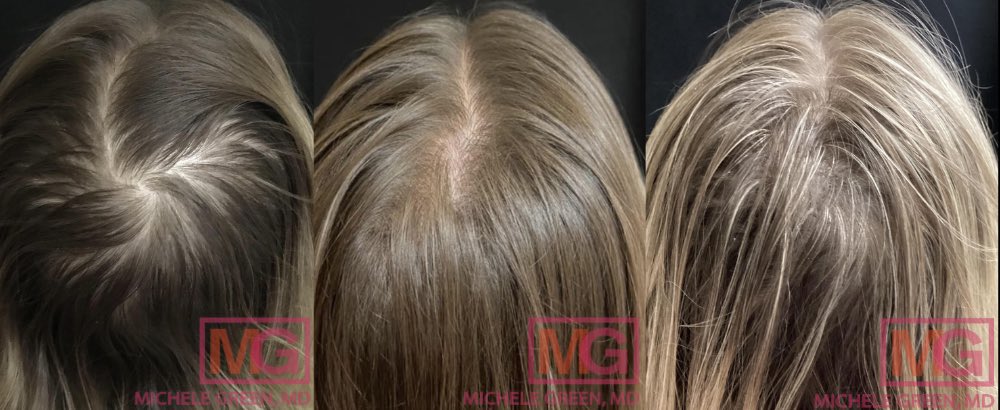
Before and after 3 and 5 sessions of PRP, 6 months then 14 months
Platelet Rich Plasma (PRP) for Female Pattern Hair Loss
Platelet-rich plasma (PRP) is an effective hair loss treatment that harnesses stem cell technology to stop thinning and promote regrowth in both male and female patients. PRP scalp injections offer a non-invasive approach to hair restoration, utilizing the patient’s natural proteins and growth factors to foster healthy new hair growth. The PRP procedure involves drawing blood, which is then centrifuged to separate red blood cells from the plasma. The plasma is collected and injected into areas with hair loss to stimulate new hair growth. By using the epidermal growth factors present in concentrated platelet-rich plasma, proteins and growth factors are reintroduced into the scalp, aiding in the rejuvenation of weakened hair follicles and enhancing new hair growth.
Platelet-rich plasma therapy (PRP) employs various beneficial growth factors to foster blood vessel formation around hair follicles, boost cell growth, and stimulate collagen production. These growth factors include platelet-derived growth factor, vascular endothelial growth factor, epidermal growth factor, fibroblast growth factor-2, and insulin-like growth factor-1, among others. The regenerative advantages of platelet-rich plasma treatment have been shown to address a variety of health issues, from orthopedics to endodontics to dermatology. Most patients need a series of four treatment sessions, each scheduled one month apart, to kickstart hair regrowth. Patients generally begin to notice hair growth after the last PRP session, and Dr. Green typically recommends a follow-up three months after the final treatment in the initial series to assess the results. After completing their initial series of treatments, many patients opt for semi-annual maintenance sessions to maintain optimal results. PRP treatments can complement other hair loss therapies, including supplements, topical treatments, oral medications, and the Keravive scalp facial.
Oral Medications for female pattern baldness
There are several oral treatment options available for female patients. The medications included in your hair loss treatment plan should be selected and monitored by an experienced, board-certified dermatologist, such as Dr. Michele Green in NYC. Oral hair loss medications are not safe to use during pregnancy or breastfeeding, so it is vital to inform your doctor if you are pregnant or planning to become pregnant before starting the medication or during treatment. The following section outlines the various oral treatment options for female pattern hair loss. With any hair loss treatment, noticeable improvement may take several months, as hair growth is a gradual process.
Spironolactone is an anti-androgen medication and the most commonly prescribed oral treatment for women experiencing adult acne and hair loss. It plays a role in hormone regulation and is particularly beneficial for female patients with PCOS-related hair loss. Spironolactone has received FDA approval and acts as a hair loss treatment by slowing the production of male androgen hormones. The androgen hormone dihydrotestosterone (DHT) can inhibit hair growth; therefore, spironolactone decreases DHT production, which in turn supports hair growth. A board-certified dermatologist must monitor treatment with spironolactone to allow for necessary adjustments, as potential side effects can include lightheadedness, fatigue, and irregular periods.
Oral minoxidil was initially prescribed to regulate high blood pressure when it was discovered that one of its side effects was new hair growth. Since then, a low dose of oral minoxidil has proven to be a safe and effective treatment for hair loss. Oral minoxidil strengthens hair follicles, promoting greater retention and regrowth of hair. In clinical trials, nearly 80% of patients reported that their hair became thicker and longer while using oral minoxidil. For many, the oral form of minoxidil is a convenient alternative to the topical version, as it does not leave residue on the scalp, is simpler to use than applying a solution twice daily, and can be safely combined with other hair loss treatments.
Finasteride, commonly known as Propecia, has received FDA approval for treating hair loss. It works by inhibiting the conversion of testosterone to dihydrotestosterone (DHT) in the body, leading to decreased DHT levels. DHT is an androgen hormone that contributes to male sex characteristics, including facial and body hair. It can attach to hair follicles, obstructing new hair growth. Propecia effectively addresses hair loss and thinning in both men and postmenopausal women. However, women who are pregnant or planning to become pregnant should avoid using finasteride, as the medication may lead to congenital disabilities.
Dutasteride, similar to finasteride, treats hair thinning and loss by inhibiting the conversion of testosterone to dihydrotestosterone (DHT). DHT can bind to androgen receptors in the scalp, which causes hair follicles to stop producing new hair. Although Dutasteride has not yet received FDA approval, recent clinical studies showcase its benefits as a hair loss treatment. A board-certified dermatologist, such as Dr. Michele Green in NYC, may prescribe oral Dutasteride for “off-label” use if deemed medically appropriate for a patient.
Oral contraceptives can help regulate hormones that may contribute to thinning hair and hair loss. Some forms of birth control may lead to hair loss in some women, while others with androgenetic alopecia may benefit from taking certain types of birth control pills as a treatment for hair loss. Due to the varied effects, consulting an expert regarding oral contraceptives for treating hair loss is essential. An effective oral contraceptive must have a low androgen index to aid in hair loss treatment. Low-androgen birth control can help regulate hormones and promote an extended anagen phase of hair growth, resulting in increased hair production and an overall reduction in hair loss and thinning.
Topical Minoxidil for female alopecia
Topical minoxidil is one of the most studied hair loss medications. It can be used topically or orally and is an FDA-approved over-the-counter treatment for hair loss. It can prevent and address hair loss in individuals with a family history of the condition. Rogaine is the brand name for topical minoxidil, which is available in foam or liquid form. Topical and oral minoxidil should not be used concurrently. Nevertheless, choosing one of these hair loss treatment options can help prevent thinning hair and hair loss.
Dr. Green’s proprietary line of products, MGSKINLABs, features two specially formulated topical hair serums designed to help prevent further loss and thinning while promoting hair regrowth. The formulas combine 7% minoxidil with either 0.1% topical finasteride (Hair Serum for Men) or 0.1% progesterone (Hair Serum for Women). Dr. Green recommends the appropriate serum for each patient based on their age, gender, and her evaluation of their hair loss condition. The synergy of minoxidil with finasteride or progesterone enhances the medication’s effects and delivers optimal results for hair restoration. With regular use of the topical serum, you will experience reduced shedding and thicker, fuller-looking hair. Dr. Green’s hair serum line is among the few products available that combines both topical minoxidil and finasteride or progesterone synergistically, offering the ultimate formulation for hair restoration.
Hydrafacial Keravive for hair loss
The Keravive treatment by HydraFacial is a three-step, medical-grade facial for the scalp. Excess oil and debris can accumulate on the scalp, leading to inflammation and irritation. Inflammation around the hair follicles can impede hair growth, resulting in hair thinning and hair loss. The Keravive scalp treatment begins with a deep cleanse and scalp exfoliation, which removes impurities and excess oil. Next, the Keravive peptide complex solution is applied to the scalp, containing various growth factors and proteins that hydrate the hair follicles. The Keravive treatment stimulates increased blood circulation to the scalp, enhancing nutrient flow to the area and improving the health of hair follicles. At the conclusion of the in-office procedure, patients receive the Keravive peptide complex spray to use at home for the 3-4 weeks following the treatment. Most patients observe the best results after participating in three Keravive treatment sessions, each spaced one month apart. Keravive is a safe hair loss treatment that can be combined with other methods.
Surgical options for women’s hair loss
Women’s hair loss treatment can be complex, and some women may turn to surgical options for treatment when hair loss is severe and desired results aren’t achievable with non-invasive options. Hair transplantation is a possible surgical solution for female pattern hair loss. The procedure entails that hair follicles are extracted from a healthy part of the scalp and surgically transplanted to the site where the patient is experiencing hair loss. This hair transplant can encourage new hair growth and help to maintain healthy hair. In addition, hair transplant surgeries are often complemented by the use of platelet-rich plasma therapy to maximize hair regrowth.
How to prevent female hair loss and balding in women
Though female pattern hair loss is often caused by genetics and cannot be fully prevented, certain actions can help maintain a healthy scalp and hair follicles during the growth phase. The first step in addressing hair loss is to consult a board-certified dermatologist, such as Dr. Michele Green in New York City. Dr. Green has over 25 years of experience providing her patients from around the world with the most cutting-edge, innovative treatment options, including those for hair loss. Many patients aim to prevent hair loss before it occurs, and Dr. Green will physically assess your scalp and hair condition, discussing your medical and family history in detail. She will then collaborate with you to create a proactive treatment plan that incorporates lifestyle changes, topical treatments, and oral medications to minimize hair loss before it begins.
First, maintaining a balanced diet rich in iron, zinc, and Vitamin D—such as red meat, beans, chickpeas, fish, and eggs—can enhance the health and growth of hair follicles during the anagen phase. Biotin supplements have been suggested as an effective treatment for improving hair and nail health, although research is still ongoing to establish their effectiveness. Several natural ingredients can also be applied topically to combat thinning hair, including rosemary oil, keratin, vitamin B5, and creatine. In daily life, limiting daily stressors or chronic stress and practicing stress relief techniques can be crucial in preventing hair loss, as stress can trigger unwanted hair shedding. Additionally, avoiding tight hairstyles that strain the hair follicles—such as braids and tight ponytails—and opting instead for loose ponytails, clips, or soft coverings can help prevent damage to the hair follicles.
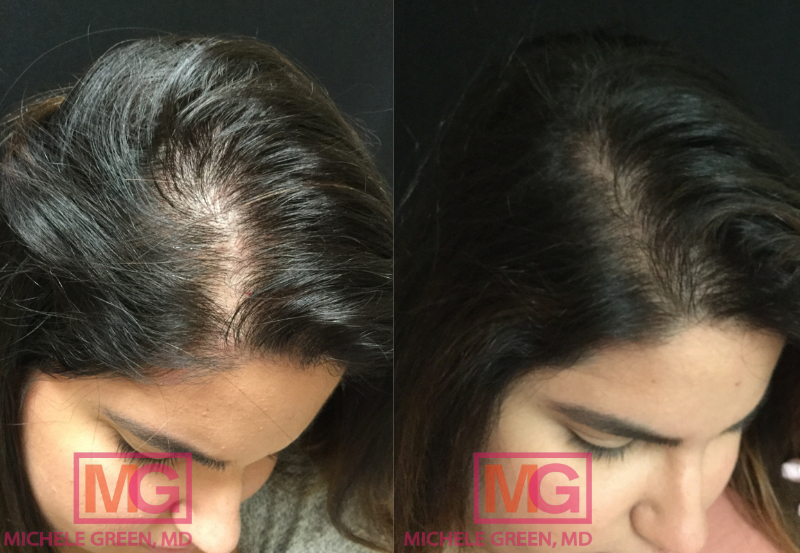
Before and after 2 sessions of PRP
Most Common FAQS for female pattern hair loss:
Does women’s hair thin with age?
Yes. As we age, we notice many changes in our hair, with the most noticeable being alterations in color and thickness of the strands. Additionally, many individuals observe that their hair becomes thinner and grows more slowly. These changes affect both men and women. Hair strands diminish in size and contain less pigment, causing the thick hair of our youth to transition into thin, fine, light-colored strands.
Do women care about hair loss?
Yes! Hair loss is a distressing condition that many women worry about. Women often use wigs, scarves, and various hairstyles to conceal hair loss. Approximately 50% of women will experience some form of hair loss during their lifetime. Like men, women facing hair loss seek ways to treat and reverse it. When experiencing noticeable hair loss, women frequently consult a board-certified dermatologist, such as Dr. Michele Green in NYC. During a consultation with Dr. Michele Green, she gathers your complete medical history, conducts a physical evaluation, and performs any necessary tests to determine the best treatment options to stop your hair loss.
How to stop women’s hair loss
A common question in Dr. Green’s boutique dermatology office is, “What helps with women’s hair loss?” Female pattern hair loss is a medical condition without a cure, meaning it cannot be completely averted for many women. However, Dr. Green offers a variety of treatments that can help reduce hair loss and encourage new hair growth and regrowth. In addition to medications and in-office procedures, lifestyle adjustments can maintain healthy hair. Stress is one of the underlying causes of hair loss, so finding effective ways to manage it can help regulate systemic cortisol levels. Cortisol, the stress hormone, can cause hair loss when elevated. Nutrient deficiencies can also lead to hair loss. Lowering stress levels and maintaining a healthy diet can help prevent this issue. The best way to halt hair loss is to consult with a board-certified dermatologist like Dr. Michele Green. In her private dermatology office, Dr. Green provides patients access to simple, non-invasive treatments such as PRP, topical and oral medications, and Keravive scalp treatment, among other cosmetic and medical options.
Why am I losing my hair as a woman?
When patients ask, “What causes women’s hair to fall out?” the answer lies in the various potential causes unique to each type of hair loss condition. In the case of androgenetic alopecia, this condition has a genetic predisposition that contributes to an imbalance in androgen hormones within the body. As a result, hair follicles weaken, leading to hair loss and thinning. For those affected by alopecia areata, risk factors for developing symptoms may include stress, thyroid issues, diabetes, and anemia. A traumatic event, such as surgery, injury, chronic stress, or even labor after pregnancy, can trigger temporary widespread shedding known as telogen effluvium. Some patients may notice hair loss as a side effect of certain medications, including cancer treatments. During your consultation with Dr. Green, she will work to identify the root cause of your hair loss and determine the most effective treatment method.
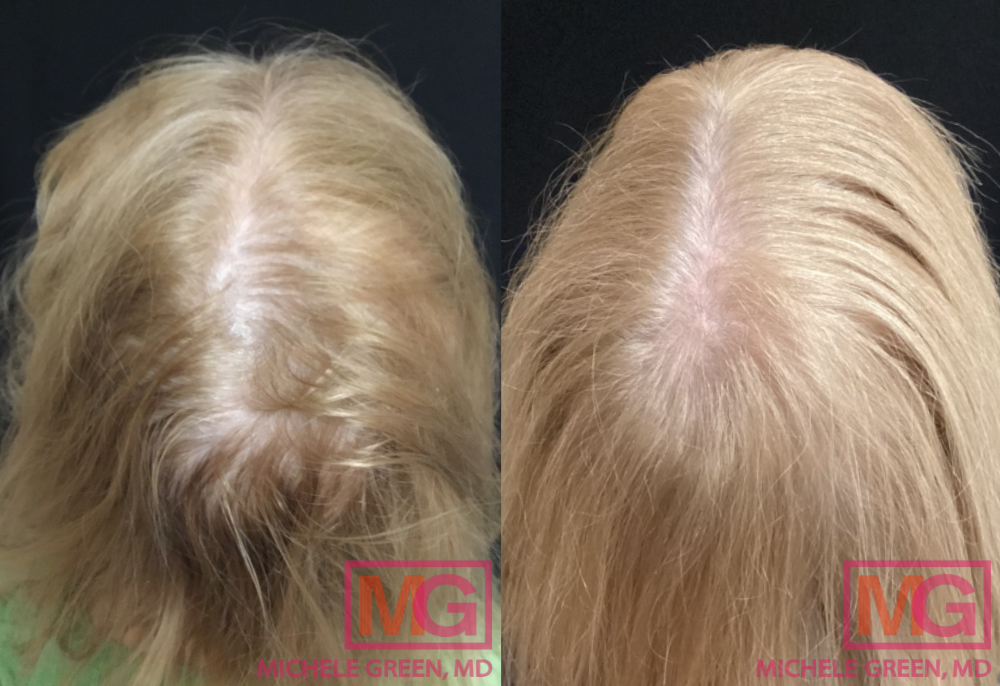
Does stress cause hair loss in women?
Stress can lead to sudden hair loss in both men and women. Extreme or sudden hair loss in women, known as telogen effluvium, can be triggered by stressors such as major illnesses or surgeries, certain medications, pregnancy and childbirth, underlying health conditions (like thyroid disorders, psoriasis, lupus, PCOS, or anemia), radiation therapy, extreme dieting or weight loss, and emotional distress, among others. Once the stressor is removed, hair shedding will decrease, and hair will return to its normal growth cycle. A wide variety of conditions may contribute to women’s hair loss, and the most effective way to identify the cause is to consult a hair loss specialist, such as board-certified dermatologist Dr. Michele Green. During your initial hair loss consultation with Dr. Green, she will physically evaluate the condition of your scalp and hair and discuss your medical and family history in detail to create a personalized hair loss treatment plan that best meets your specific needs needs.
Why women’s hair loss occurs
Women experience hair loss for various reasons, making it challenging to identify the cause. A hair loss specialist like Dr. Green can determine your hair loss pattern through a physical evaluation and may order necessary tests, including blood tests and scalp biopsies. Dr. Green will engage in a thorough discussion of your medical and family history, as well as review lifestyle practices and behaviors that could impact your hair loss. Together with Dr. Green, you will develop a personalized treatment plan that includes in-office procedures, topical treatments, oral medications, supplements, and innovative devices to prevent further hair loss and encourage new, healthy hair growth.
What does female hair loss look like?
Many of Dr. Green’s patients ask, “Where does female pattern baldness start?” Androgenic alopecia begins at the center of the scalp near the part. Female pattern hair loss, also known as androgenic alopecia, is among the most common types of hair loss. This condition is characterized by a pattern that appears as a widening center part. It often resembles an upside-down Christmas tree centered around the part. A dermatologist, such as Dr. Michele Green in New York City, can diagnose female pattern hair loss by examining the scalp and hair condition, as well as recognizing the existing pattern of hair loss.
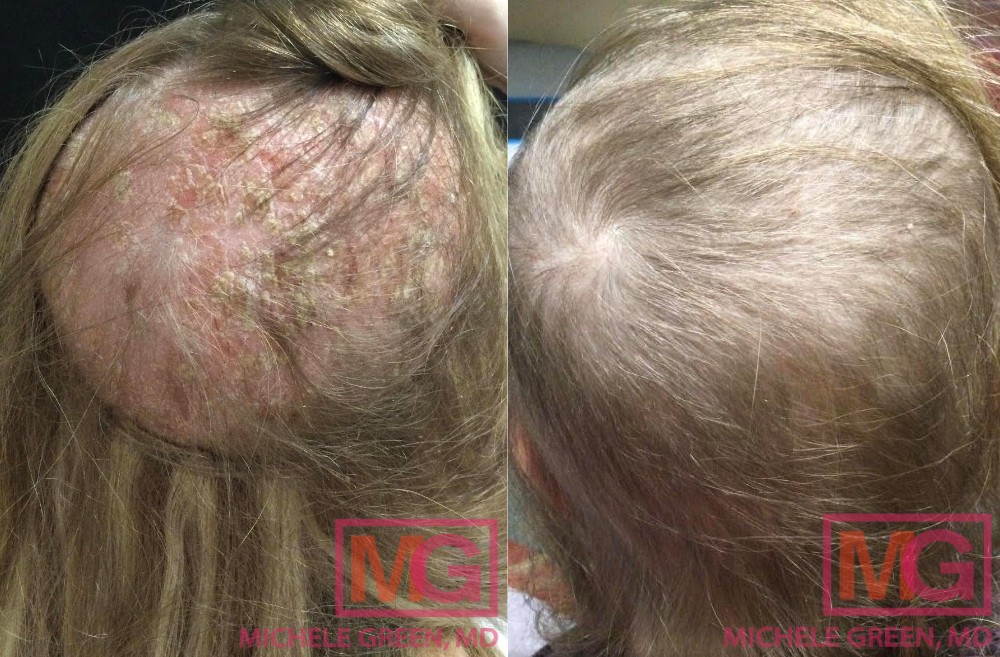
Before and after 2 sessions of PRP
How to fix female hair loss
Unfortunately, there is no cure for androgenic alopecia. However, many treatment options can help women dealing with thinning hair. The first step in addressing hair thinning is to consult a board-certified dermatologist, such as Dr. Michele Green in NYC. During your initial consultation regarding hair loss, Dr. Green will identify the root cause of your thinning hair or hair loss and recommend the most suitable treatment or treatments to meet your needs. When addressing thinning hair, Dr. Green may suggest prescription options like topical and oral minoxidil, topical and oral Propecia, or oral spironolactone, which promote hair regrowth and slow hair loss. She might also recommend platelet-rich plasma treatment (PRP injections) to strengthen hair follicles. It is essential to collaborate with a hair loss expert to develop a treatment plan tailored to your specific needs and include the best options for you.
What to do for women’s hair loss
When patients ask, “What is good for women’s hair loss?” the answer is that there are numerous options available at Dr. Michele Green’s dermatology office, which is internationally renowned and staffed by board-certified dermatologists. In-office procedures like PRP can slow hair loss and promote hair growth by supporting scalp and hair follicle health. If a hormone imbalance is causing hair loss or thinning, spironolactone or an oral contraceptive may be recommended. These treatments can address the root cause of the condition and help prevent further hair loss. Oral treatments like finasteride or minoxidil can aid women experiencing hair loss by stimulating hair growth and strengthening the hair follicles. Hair loss can progress rapidly, making it more challenging to regrow hair, so it is crucial to consult a hair loss specialist, such as Dr. Michele Green, early in the hair loss process.
What vitamins are good for women’s hair loss?
Deficiencies in various vitamins and nutrients can lead to hair loss, and supplementing these elements may help support the scalp and reduce hair loss. Certain supplements that contain vitamins such as biotin, vitamin C, and vitamin B have been clinically proven to enhance the appearance of thinning hair by promoting hair growth. One of the most popular vitamin supplements is Nutrafol, which is rich in biotin as well as vitamins B and C to foster new hair growth. Additionally, Nutrafol addresses hormone imbalances, alleviates stress, and enhances nutrient levels, tackling the root causes of hair loss. While research is ongoing, the positive effects of vitamin supplements in promoting hair growth are already being observed.
What to use for women’s hair loss?
It is challenging to manage, and a common question is, “How can I treat women’s hair loss?” Depending on the type of hair loss and its underlying causes, there are several options available. Common treatment options for women’s hair loss include oral medications, topical ointments and serums, vitamin supplements, and in-office procedures such as Platelet-rich plasma injections. The best way to begin the treatment process is to consult with a board-certified dermatologist, like Dr. Michele Green, to determine the type of hair loss you’re experiencing and the most effective solution to address the underlying cause. After your initial consultation with Dr. Green, during which she will examine the treatment area and perform any necessary blood work, she will recommend the treatment or combination of treatments that will be most suitable for you.
Can female hair loss be reversed?
Many of Dr. Green’s patients ask, “Can female hair loss grow back?” The answer is yes; female pattern hair loss can indeed grow back. To effectively treat female hair loss, it is important to seek help from a hair loss specialist as early as possible. Addressing hair loss early in its progression is the best way to prevent severe hair loss and encourage new hair growth. The first step in treating hair loss and achieving regrowth for women is to schedule an appointment with a board-certified dermatologist, such as Dr. Michele Green in New York City, to receive tailored recommendations regarding optimal treatment options suited to your specific needs. Numerous treatment options are available, including topical minoxidil, oral medications, in-office procedures like PRP, and supplements such as Nutrafol.
Dr. Green often combines treatment methods, utilizing platelet-rich plasma injections alongside topical or oral medications to promote hair growth. Platelet-rich plasma (PRP) injections can help strengthen hair follicles and encourage thicker, healthier hair regrowth. PRP is derived from a sample of the patient’s blood and contains many nutrients and growth factors that contribute to hair follicle health. Given the many potential underlying causes of hair loss and the numerous treatment options available, consulting with an expert like Dr. Green is imperative to maximize hair regrowth.
Will hair loss during menopause grow back?
Hair loss during menopause is not permanent and may regrow; however, it can return with a different texture and color. Fluctuating hormones, especially during menopause when estrogen levels drop, can trigger or worsen hair loss. Estrogen helps maintain hair in the resting phase, and lower levels often cause hair to shift from the resting phase to the shedding phase. Hormonal hair loss can often be reversed after menopause once hormone levels rebalance. Your healthcare provider may recommend hormone replacement therapy during perimenopause or menopause to alleviate symptoms like hair loss. To promote hair growth after menopause, a hair loss expert, such as board-certified dermatologist Dr. Michele Green in NYC, might suggest treatment options like topical serums, oral medications or supplements, and platelet-rich plasma injections, among others.
How do I get started with treating my female hair loss today?
Hair loss in women can be a devastating condition, and thinning and shedding can lead to feelings of self-consciousness and low self-esteem. Various factors may contribute to hair loss and thinning, including genetics, hormonal imbalances, stress, diet, hair styling practices, underlying health conditions, certain medications, and more. A hair loss specialist, such as Dr. Michele Green in NYC, can help identify the underlying causes of hair loss and recommend the most effective treatments to prevent further loss and encourage new hair growth. In any case, the best strategy for preventing and treating thinning hair or hair loss is to seek an early evaluation by a board-certified dermatologist like Dr. Green in NYC.
Dr. Green is an internationally recognized leader in dermatology, boasting over 25 years of experience treating patients worldwide for hair loss. She has the expertise required to create a customized hair loss treatment plan that effectively addresses the underlying causes, helping female patients maximize retention and promote the growth of beautiful, healthy hair. She is consistently ranked among the top dermatologists in New York by New York Magazine, Super Doctors, Castle Connolly, and The New York Times. When you consult with Dr. Green in her private boutique dermatology office on the Upper East Side of Manhattan, you will review your medical history and any prior cosmetic procedures. As an authority in cosmetic dermatology, Dr. Green will recommend a unique combination of cutting-edge treatment techniques, specially formulated topical haircare, oral medications, innovative hair loss treatment devices, and supplements. To schedule a consultation with Dr. Green and begin your journey toward treating hair loss for thicker, healthier, beautiful hair, call her NYC-based office at 212-535-3088 or contact us online.
 212-535-3088
212-535-3088 